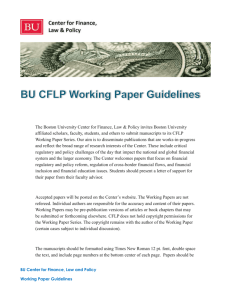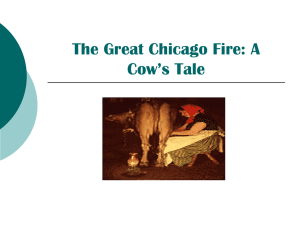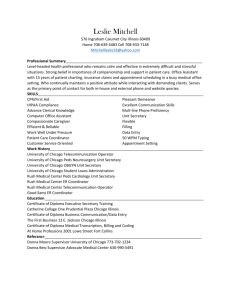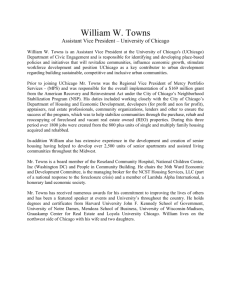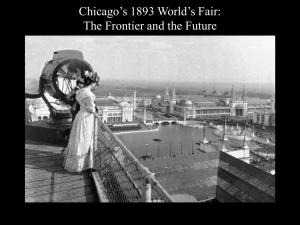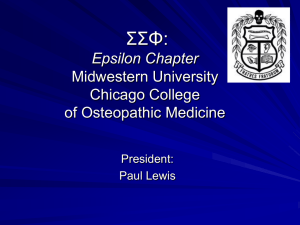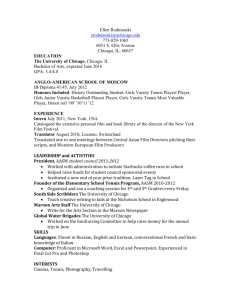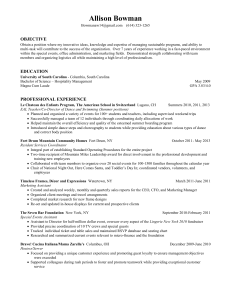Chicago Manual of Style (or, Turabian)
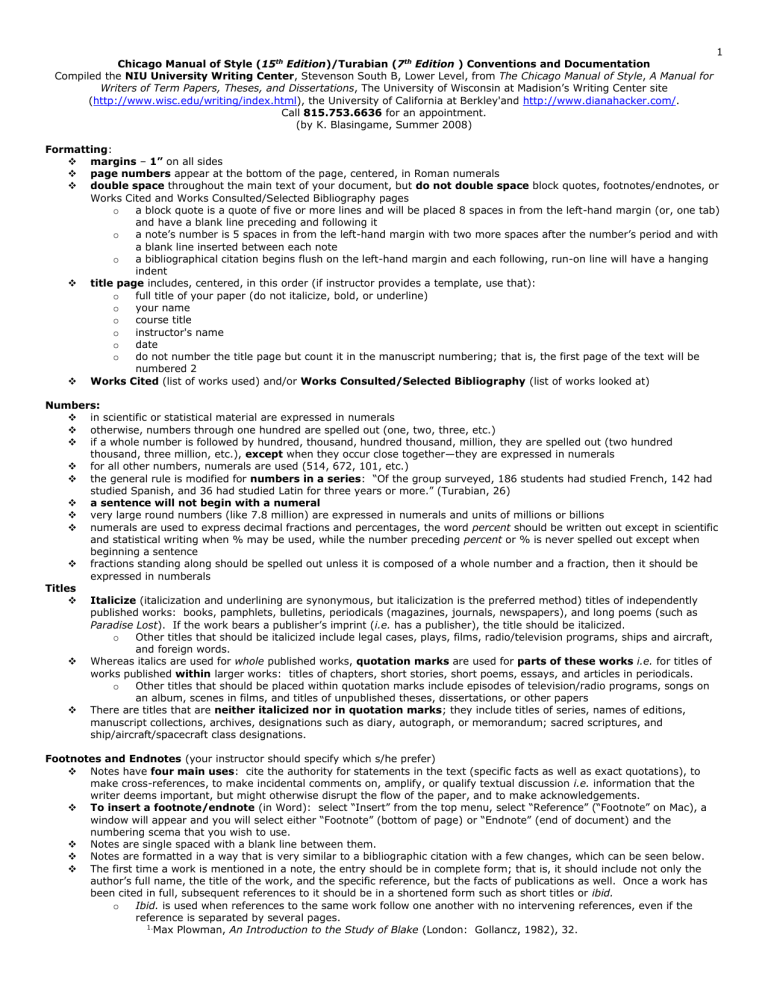
Chicago Manual of Style (15 th Edition)/Turabian (7 th Edition ) Conventions and Documentation
Compiled the NIU University Writing Center, Stevenson South B, Lower Level, from The Chicago Manual of Style, A Manual for
1
Writers of Term Papers, Theses, and Dissertations, The University of Wisconsin at Madision’s Writing Center site
( http://www.wisc.edu/writing/index.html
), the University of California at Berkley'and http://www.dianahacker.com/ .
Call 815.753.6636 for an appointment.
(by K. Blasingame, Summer 2008)
Formatting:
margins – 1” on all sides
page numbers appear at the bottom of the page, centered, in Roman numerals
double space throughout the main text of your document, but do not double space block quotes, footnotes/endnotes, or
Works Cited and Works Consulted/Selected Bibliography pages o a block quote is a quote of five or more lines and will be placed 8 spaces in from the left-hand margin (or, one tab) and have a blank line preceding and following it o a note’s number is 5 spaces in from the left-hand margin with two more spaces after the number’s period and with a blank line inserted between each note o a bibliographical citation begins flush on the left-hand margin and each following, run-on line will have a hanging indent
title page includes, centered, in this order (if instructor provides a template, use that): o full title of your paper (do not italicize, bold, or underline) o your name o course title o instructor's name o date o do not number the title page but count it in the manuscript numbering; that is, the first page of the text will be numbered 2
Works Cited (list of works used) and/or Works Consulted/Selected Bibliography (list of works looked at)
Numbers:
in scientific or statistical material are expressed in numerals
otherwise, numbers through one hundred are spelled out (one, two, three, etc.)
if a whole number is followed by hundred, thousand, hundred thousand, million, they are spelled out (two hundred thousand, three million, etc.), except when they occur close together—they are expressed in numerals
for all other numbers, numerals are used (514, 672, 101, etc.)
the general rule is modified for numbers in a series: “Of the group surveyed, 186 students had studied French, 142 had studied Spanish, and 36 had studied Latin for three years or more.” (Turabian, 26)
a sentence will not begin with a numeral
very large round numbers (like 7.8 million) are expressed in numerals and units of millions or billions
numerals are used to express decimal fractions and percentages, the word percent should be written out except in scientific and statistical writing when % may be used, while the number preceding percent or % is never spelled out except when beginning a sentence
fractions standing along should be spelled out unless it is composed of a whole number and a fraction, then it should be expressed in numberals
Titles
Italicize (italicization and underlining are synonymous, but italicization is the preferred method) titles of independently published works: books, pamphlets, bulletins, periodicals (magazines, journals, newspapers), and long poems (such as
Paradise Lost). If the work bears a publisher’s imprint (i.e. has a publisher), the title should be italicized. o Other titles that should be italicized include legal cases, plays, films, radio/television programs, ships and aircraft, and foreign words.
Whereas italics are used for whole published works, quotation marks are used for parts of these works i.e. for titles of works published within larger works: titles of chapters, short stories, short poems, essays, and articles in periodicals. o Other titles that should be placed within quotation marks include episodes of television/radio programs, songs on an album, scenes in films, and titles of unpublished theses, dissertations, or other papers
There are titles that are neither italicized nor in quotation marks; they include titles of series, names of editions, manuscript collections, archives, designations such as diary, autograph, or memorandum; sacred scriptures, and ship/aircraft/spacecraft class designations.
Footnotes and Endnotes (your instructor should specify which s/he prefer)
Notes have four main uses: cite the authority for statements in the text (specific facts as well as exact quotations), to make cross-references, to make incidental comments on, amplify, or qualify textual discussion i.e. information that the writer deems important, but might otherwise disrupt the flow of the paper, and to make acknowledgements.
To insert a footnote/endnote (in Word): select “Insert” from the top menu, select “Reference” (“Footnote” on Mac), a window will appear and you will select either “Footnote” (bottom of page) or “Endnote” (end of document) and the numbering scema that you wish to use.
Notes are single spaced with a blank line between them.
Notes are formatted in a way that is very similar to a bibliographic citation with a few changes, which can be seen below.
The first time a work is mentioned in a note, the entry should be in complete form; that is, it should include not only the author’s full name, the title of the work, and the specific reference, but the facts of publications as well. Once a work has been cited in full, subsequent references to it should be in a shortened form such as short titles or ibid. o Ibid. is used when references to the same work follow one another with no intervening references, even if the reference is separated by several pages.
1.
Max Plowman, An Introduction to the Study of Blake (London: Gollancz, 1982), 32.
2.
Ibid.
3.
Ibid., 68. (This reference is the same author, same text, same everything as the previous note, but a different page number. If it is another work by the same author, Ibid. cannot be used.) o A shortened reference occurs when a source is repeated, but is not sequential. A title should be shortened to its key words if it is six or more words: The Essential Tension: Selected Studies in Scientific Tradition and Change to
2
Essential Tension.
1.
Max Plowman, An Introduction to the Study of Blake (London: Gollancz, 1982), 32.
2.
Abdul al-Achmad, Immunization and Chemotherapy (Chicago: Blitzstein, 1994), 247.
3.
Plowman, Study of Blake, 125. (This type is used when there is more than one book by an author.)
4.
Al-Achmad, 382. (This type is used when there is only one book by an author.)
Indirect source/Citation taken from a Secondary Source (if you are using a quotation that appeared in a source you are using—in other words, not the original quotation, but a quotation of a quotation)
References to the work on one author as quoted in that of another must cite both works:
1.
Louis Zukofsky, “Sincerity and Objectification,” Poetry 37 (February 1931): 269, quoted in Bonnie Costello, Marianne
Moore: Imaginary Possessions (Cambridge: Harvard University Press, 1981), 78.
If the purpose of such a reference is to emphasize the secondary author’s quoting of the original work, use the following style:
2.
Bonnie Costello, Marianne Moore: Imaginary Possessions (Cambridge: Harvard University Press, 1981), 78, quoting
Louis Zukofsky, “Sincerity and Objectification,” Poetry 37 (February 1931): 269.
Sample Bibliography Entries
All entries should be listed alphabetically by author.
*Bibliographies are single spaced with one blank line between entries.
The first line is flush left and then all subsequent lines have a hanging indent.*
This is meant to be a basic guide. Oftent, types are hybridized. For a more complete list, please see manual.
Book with one author N
B
1.
John Hope Franklin, George Washington Williams: A Biography (Chicago:
University of Chicago Press, 1985), 54.
Franklin, John Hope. George Washington Williams: A Biography. Chicago:
University of Chicago Press, 1985.
Book with two authors
Book with anonymous/no author
N
B
N
B
1.
1.
Robert Lynd and Helen Lynd, Middletown: A Study in American Culture (New
York: Harcourt, Brace and World, 1929), 67.
Lynd, Robert and Helen Lynd, Middletown: A Study in American Culture. New
York: Harcourt, Brace and World, 1929.
The Lottery (London: J Watts, 1931), 20-25.
The Lottery. London: J. Watts, 1931.
Work in an anthology/Chapter in Book
Institution or Association listed as author
Editor or Compiler as Author
Author’s Work Contained in
Collected Works
B
N
N
B
N
B
B
N 1.
in Dissing Elizabeth: Negative Representations of Gloriana, ed. Julia M. Walker
(Durham: Duke University Press, 1998), 153-184.
Betts, Hannah. "The Image of this Queene so Quaynt: The Pornographic Blazon
1.
1.
1588-1603." In Dissing Elizabeth: Negative Representations of Gloriana, edited by Julia M. Walker, 153-184. Durham: Duke University Press, 1998.
American Library Association, Young Adult Services Division, Services
Statement Development Committee, Directions for Library Service to Young Adults
(Chicago: American Library Association, 1978), 25.
American Library Association, Young Adult Services Division, Services Statement
Development Committee. Directions for Library Services to Young Adults.
Chicago: American Library Association, 1978.
1984), 225. von Hallberf, Robert, ed. Cannons. Chicago: University of Chicago Press, 1984.
1.
Hannah Betts, "The Image of this Queene so Quaynt: The Pornographic Blazon,"
Robert von Hallberf, ed., Cannons (Chicago: University of Chicago Press,
The Complete Works of Samuel Taylor Coleridge, ed. W. G. T. Shedd, vol. 1,
Aids to Reflection (New York: Harper & Bros., 1884), 18.
Coleridge, Samuel Taylor. The Complete Works of Samuel Taylor Coleridge. Edited
Book in a Series
Article in a journal with volume numbers only
Article in a journal that numbers issues
Article in a magazine
Article in a newspaper
News items from gaily papers are rarely listed separately in a bibliography or reference list.
Published Interview
Unpublished Interview
Unpublished Interview by
Writer of Paper
Thesis or Dissertation
Sound Recordings
Video Recordings and DVDs
B
N
N
B
N
B
N
B
B
N
N
B
N
B
N
N
B
B
N
B
N by W. G. T. Shedd. Vol. 1, Aids to Reflection. New York: Harper & Bros.,
1884.
1.
Ellen Pollak, The Poetics of Sexual Myth: Gender and Ideology in the Verse of
Swift and Pope, Women in Culture and Society (Chicago: University of Chicago
Press, 1985), 124.
Pollak, Ellen. The Poetics of Sexual Myth: Gender and Ideology in the Verse of
Swift and Pope. Women in Culture and Society. Chicago: University of
Chicago Press, 1985.
1.
Lawrence P. Smith, “Sailing Close to the Wind,” Politics in Action 10, no. 4
(1993): 82, 99-100.
Smith, Lawrence P. “Sailing Close to the Wind.” Politics in Action 10, no. 4
(1993): 80-102.
1.
Richard Jackson, “Running down the Up-Escalator: Regional Inequality in Papua
New Guinea,” Australian Geographer 14 (May 1979): 180.
Jackson, Richard. “Running down the Up-Escalator: Regional Inequality in Papua
New Guinea.” Australian Geographer 14 (May 1979): 175-84.
1.
Bruce Weber, “The Myth Maker: The Creative Mind of Novelist E. L. Doctorow,”
New York Times Magazine, 20 October 1985, 42.
Weber, Bruce. “The Myth Maker: The Creative Mind of Novelist E. L. Doctorow.”
1.
New York Times Magazine, 20 October 1985, 42.
Irish Daily Independent (Dublin), 16 June 1904.
1.
John Fowles, “A Conversation with John Fowles,” interview by Robert Foulke
(Lyme Regis, 3 April 1984), Salmagundi, nos. 68-69 (fall1985-winter 1986): 370.
Fowles, John. “A Conversation with John Fowles.” Interview by Roert Foulke
(Lyme Regis, 3 April 1984). Salmagundi, nos. 68-69 (fall 1985-winter
1986): 367-84.
1.
Benjamin Spock, interview by Milton J. E. Senn, 20 November 1974, interview
67A, transcript, Senn Oral History Collection, National Library of Medicine,
Bethesda, Md.
Spock, Benjamin. Interview by Milton J. E. Senn, 20 November 1974. Interview
67A, transcript. Senn Oral History Collection, National Library of Medicine,
Bethesda, Md.
1.
Mayor Harold Washington of Chicago, interview by author, 23 September 1985,
Chicago, tape recording, Chicago Historical Society, Chicago.
Washington, Harold, mayor of Chicago. 1985. Interview by author, 23 September,
Chicago. Tape recording. Chicago Historical Society, Chicago.
1.
Gilberto Artioli, “Structural Studies of the Water Molecules and Hydrogen
Bonding in Zeolites” (Ph.D. diss., University of Chicago, 1985), 10.
Artioli, Gilberto. “Structural Studies of the Water Molecules and Hydrogen Bonding in Zeolites.” Ph.D. diss., University of Chicago, 1985.
1.
Norman Mailer, The Naked and the Dead, excerpts read by the author,
Caedmon CP1619, 1983, cassette.
Mailer, Norma. The Naked and the Dead. Excerpts read by the author. Caedmon
CP1619, 1983. Cassette.
1.
Itzak Perlman: In My Case Music, prod. And dir. Tony DeNonno, 10 min.,
DeNonno Pix, 1985, videocassette.
Perlman, Itzak. Itzak Perlman: In My Case Music. Produced and Directed by Tony
3
Performances
Works of Art
Actual works of art are normally not included in a bibliography or reference list.
Works of Art Reproduced in
Books
Pamphlets, reports, and the like
Pamphlet and such are treated essentially as books.
Electronic Document
Online archive of a print journal
Online Journal Article
Online magazine article
Newspaper article online
News items from daily newspapers are rarely listed in a bibliography or reference list, unless the newspaper is referred to several times and constitutes a substantial part of the documentation.
N
N
B
B
N
B
N
B
N
B
N
N
B
N
N
DeNonno. 10 min. DeNonno Pix, 1985. Videocassette.
1.
William Shakespeare, The Winter’s Tale , Festival Theatre, Stratford, Ontario, 24
September 1986.
Shakespeare, William. The Winter ’s Tale . Festival Theatre, Stratford, Ontario, 24
September 1986,
1.
Jackson Pollock, Reflection of the Big Dipper, oil on canvas, 1946, Stedelijk
Museum, Amsterdam.
4
1.
Thomas Nast, “The Tammany Tiger Loose: ‘What Are You Going to Do about
It,’” cartoon, Harper’s Weekly , 11 November 1871, as reproduced in J. Chal Vinson,
Thomas Nast: Political Cartoonist (Athens: University of Georgia Press, 1967), plate 52.
Nast, Thomas. “The Tammany Tiger Loose: ‘What Are You Going to Do about
It.’” Cartoon. Harper’s Weekly , 11 November 1871. As reproduced in J.
Chal Vinson, Thomas Nast: Political Cartoonist, plate 52. Athens:
University of Georgia Press, 1967.
1.
Hazel V. Clark, Mesopotania: Between Two Rivers (Mesopotamia, OH: End of the Commons General Store, 1957).
1.
Rosabel Flax, Guidelines for Teaching Mathematics K-12 (Topeka: Kansas State
Department of Education, 1979) [database online]; available from Dialog, ERIC, ED
178312.
Flax, Rosabel. Guidelines for Teaching Mathematics K-12. Topeka: Kansas
Department of Education, 1979. Database online. Available from Dialog,
ERIC, ED 178312.
1.
Kira Sanbonmatsu, “Gender Stereotypes and Vote Choice,” American Journal of
Political Science 46 (2002), 21-22, http://www.jstor.org/view/00925853/sp030001
/03x0054b/0#&origin=sfx3Asfa (accessed March 22, 2004).
Sanbonmatsu, Kira. “Gender and Stereotypes and Vote Choice.” American Journal
of Political Science 46 (2002): 200-34, http://www.jstor.org/view/
00925853/sp030001/03x0054b/0#&origin=sfx3Asfa (accessed March 22,
2004).
1.
Edna Erez, "Domestic Violence and the Criminal Justice System: An Overview,"
Online Journal of Issues in Nursing 7, no. 1 (January 2002), http://www.nursingworld.org/ojin/topic17/tpc17_3.htm (accessed March 22,
2004).
Erez, Edna. "Domestic Violence and the Criminal Justice System: An Overview."
Online Journal of Issues in Nursing 7, no. 1 (January 2002), http://www.nursingworld.org/ojin/topic17/tpc17_3.htm (accessed March
22, 2004).
1.
Eric Boehlert, "Watch Your Mouth," Salon, March 19, 2004, http://www.salon.com/news/feature/2004/03/19/fcc/ (accessed March 22, 2004).
Boehlert, Eric. "Watch Your Mouth." Salon, March 19, 2004,
2004). http://www.salon.com/news/feature/2004/03/1/fcc/ (accessed March 22,
1.
Tanya Schevitz, "Berkeley Parents Reinvent School: Charter Program to Focus on Ability Rather Than Age," San Francisco Examiner, January 18, 1995,
Wednesday; fourth edition, http://web.lexis-nexis.com/universe/ document?_m=5b81f9bb972aef2e8ed34751f6d3002f&_docnum=16& wchp=dGLbVlb-zSkVA&_m d5=a7ced40274280aa4a3ac6bed4cd2a53a (accessed
March 22, 2004).
Online Book
Website
Always include as much information as possible when citing a website.
1.
Emma Hardinge Britten, Modern American Spiritualism: A Twenty Years'
Record of the Communion Between Earth and the World of Spirits, (New York: The
Author, 1870): 57, Making of America Collection, http://www.hti.umich.edu/cgi/t/text/text-idx?c=moa;idno=ACM3377 (accessed
March 22, 2004).
Britten, Emma Hardinge. Modern American Spiritualism: A Twenty Years' Record of
the Communion Between Earth and the World of Spirits. New York: The
Author, 1870. Making of America Collection, http://www.hti.umich.edu/ cgi/t/text/text-idx?c=moa;idno=ACM3377 (accessed March 22, 2004).
1.
Evanston Public Library Board of Trustees, “Evanston Public Library Strategic
Plan, 2000-2010: A Decade of Outreach,” Evanston Public Library, http://www.epl.org/library/strategic-plan-00.html (accessed July 18, 2002).
Evanston Publisc Library Board of Trustees. “Evanston Public Library Strategic
Plan, 2000-2010: A Decade of Outreach.” Evanston Public Library. http://www.epl.org/library/strategic-plan-00.html.
5
N
B
B
N
B
N
Website with no author per se
If there is no author per se, the owner of the site may stand in for the author.
1.
The Baha’is of the United States, “History,” The Baha’is Faith , http://www.us.bahai.org/history/index.html.
The Baha’is of the United States. “History.” The Baha’is Faith . http://www.us.bahai.org/history/index.html.
Chicago/Turabian can also use in-text citation. This is rare, but does sometimes happen. Most of the rules and examples for notes and bibliographies also apply using this system. Instead of footnotes or endnotes, provide the page(s) quoted or referred to in brief parenthetical references based on the author's last name and date of publication. After the body of your paper, you must also provide an alphabetized reference list.
The in-text citations are always enclosed in parentheses, and are composed of three elements: o The first element consists of last name(s) of one, two or three authors. Use "and others" for more than three authors, as for notes and bibliographies. If a work has no author, use the first words of the title in the parenthetical reference and as the initial element in the reference list. o Follow the first element by the year of publication, separated from the first element only by a space. o Follow the year by a comma, a space, and then the page or pages you are quoting or referring to. Omit for works lacking pagination.
For example, a single author book would appear thus (Nelson 1994, 54)

